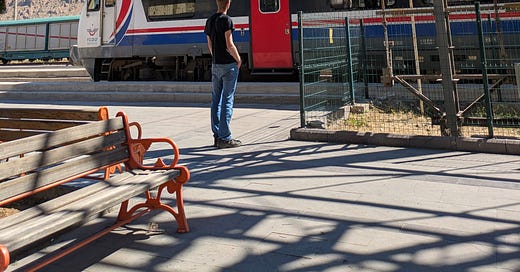The Doğu Ekspresi (or eastern express) is an overnight train than runs from Ankara, Turkey's capital, to Kars, a city in the north east near the borders with Georgia and Armenia. Officially, the 1365km journey is scheduled to take just over 26 hours. However, many sources on the internet suggest it is typically delayed making the total journey 30-33 hours. The daily “normal” train consists of around 4 cars of reclining “pullman” seats and a couple of four berth couchette sleeping cars. There is also a more expensive “touristic” train running exclusively one and two berth sleeping compartments, but this does not run every day, is much more expensive, and wasn't something we really considered.
As we were already in Cappadocia, we planned to catch the train from the city of Kayseri rather than traveling all the way to Ankara. We had read (and experienced) that the couchettes sell out quite early. Due to our ad-hoc travel style with minimal planning ahead and the Turkish railway website’s refusal to let us book tickets (possibly due to a combination of British phone numbers and credit cards), we resigned ourselves to seats for the journey. We didn't fancy 19+ hours straight sitting in seats, so we decided to break up the journey with a couple of intermediate stops. This would increase the price of the journey from 720 lira (€15.43 at time of writing) to 940 lira (€20.15) per person - a modest increase so not really a concern. Accomodation on the other hand was more of an expense, but that's the price we had to pay.
Based on journey times and attraction locations, we opted for the following steps in our journey:
Bus from Göreme to Kayseri (1 hour 5 minutes)
Train from Kayseri to Divrigi (scheduled for 7 hours, ended up being 9 hours)
One night in Divrigi
Train from Divrigi to Erzurum (scheduled for 7 hours 40 minutes, took roughly the scheduled time, but was 2 hours late arriving).
Two nights in Erzurum
Train from Erzurum to Kars (scheduled to take 4 hours, but arrived 4 hours late).
29/30-Jun-2025: Göreme to Divrigi via Kayseri
We started our journey with a public bus from Uçhisar to Göreme. Luckily our awesome hotel on Uçhisar let us check out late, so we departed just after 3pm. Our bus to Kayseri departed at 5pm. This got us to the Kayseri bus station around 6pm. The bus station is out of the city centre and away from the train station, so we had to figure out how to buy tram tickets. For some reason, our cards wouldn't work on the contactless payment gates and the nearest self service ticket kiosk was out of service. Eventually we found a manned kiosk to buy tickets, then could make our way to the city centre.
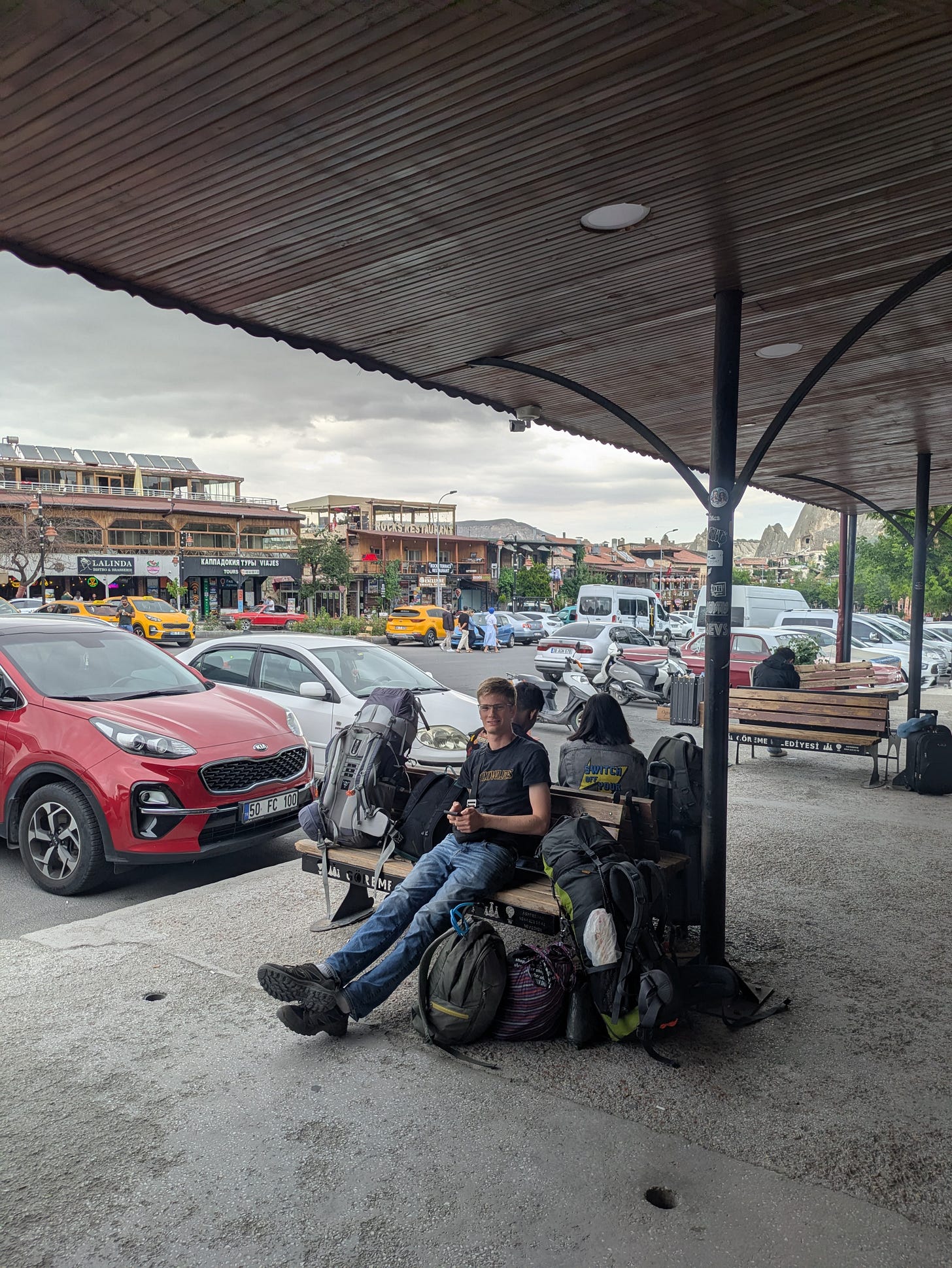
While waiting for the tram, a lady struck up conversation with us but she spoke minimal English. It turned out she had lived in Germany for nearly a decade, so Mary's broken German came in handy once again and allowed basic communication. It seems that due to historical links and job prospects in Germany, German is a helpful language to communicate with people across the Balkans and in Turkey as well - this sort of thing has been a semi-regular occurrence during the last few months of our trip!
We took a quick wander through the centre of Kayseri, but there was not much to see on a Sunday evening. Most shops were closed in what looked to be the central bazaar. We took a quick stroll through the old castle before it started to rain, so we decided to make our way towards the train station to find a place for a light dinner to kill some time - the train was not scheduled to depart until 1am.
While walking through a park, a trio of kids, maybe 10 years old, started talking to us. One spoke a bit of English and said they were from Iraq and Syria, another had a mischievous smirk an his face and kept asking us for money (to the annoyance of his friend), and the third followed along quietly. The three of them seemed to be quite entertained by a couple of strange people saddled with large backpacks and the quiet child seemed to be quite interested in the Canadian flag pin on the side of Mary's backpack. She decided to detach the pin and give it to the child, at which point it became more interesting than we were and the trio scampered off across the park.
We stopped at a hole in the wall eatery near the station for Köfte Dürüm and lentil soup for dinner before we decided to migrate to the station to buy our tickets. We purchased tickets to Divrigi but were told by the attendant that the system wouldn't let him sell us onward tickets to Erzurum - whether this was true or if he was just too lazy to type in our passport information a second time we'll never know. With that we had four hours to kill in the train station as there wasn't anything to do in the area.
Eventually our train arrived at around 1:30am and we were on our way. We did our best to catch a few hours of uncomfortable sleep in our seats. Once the sun rose, we were treated to some interesting views. The train seems to follow river valleys through low mountains. Some areas are incredibly arid and barren (with the exception of the very bottom of the valley near the river) while others were a bit greener. Combinations of elevation and climate appeared to provide different agricultural conditions; in some areas grain fields had already turned brown and looked to be nearing harvest time, in other areas fields were still green and growing. Scott's phone gps suggested we reached an elevation of about 1650m before we started to descend once again.
As the train trundled through the valley, we passed small villages which seemed to be in the middle of nowhere. We couldn't help but wonder what the residents did to provide for themselves. There were some signs of small scale agriculture and freight trains at the sides of the station suggested there may be mining in the area. Judging by the condition of the buildings, these communities seemed to be relatively poor - perhaps another sign of limited economic opportunity.
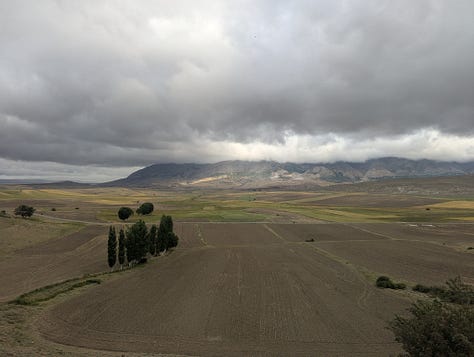
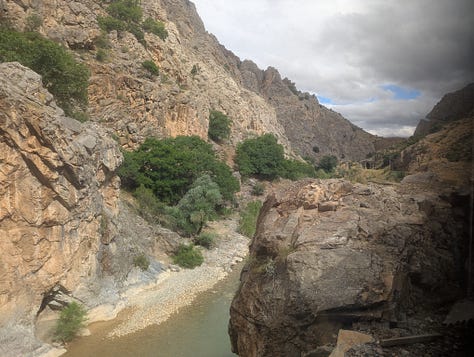
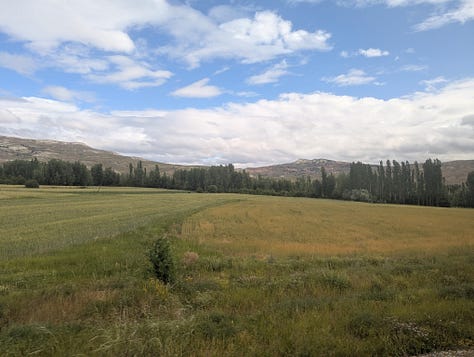
Around 10am (about two hours behind schedule), we arrived in Divrigi and set off to find our hotel. Only one hotel in the town is on booking.com and it was expensive, Scott had found another with good reviews near to the station and reserved via email using Google translate. The room was still a bit expensive at 3000 lira/€70 for the night, but we figured it was our best option and they had agreed to let us check-in when our train arrived in the morning. With the help of Google translate, we managed to check in and unload ourselves in our room. Happily, the hotel was spacious, clean, and comfortable - it would work well for our brief stay in the town.
Divrigi itself is fairly small and is located in a somewhat remote corner of central Anatolia with the primary industry being the mining of iron ore. During our visit, we felt like the only foreign tourists in the vicinity. Despite being off the beaten path, Divrigi has a notable attraction: the Great Mosque and Hospital of Divrigi. During the Seljuk Empire, Divrigi was a centre of sorts. The mosque and hospital complex was built in the 13th century; it is UNESCO listed and substantial (and lengthy) restoration works were just completed in mid-2024. Despite the restoration, there is no information about the complex on site - as with many of the sites in Turkey, a bit of research before, during, or after the visit is necessary.
The Great Mosque covers around 1280 square metres while the hospital covers 768 square metres. Although the size of the compound is impressive, the intricate carvings on each entrance are the main attraction. Each portal has a unique design and style, which leads historians to believe different groups of craftsman were responsible for their construction. UNESCO says the contrast of exuberant external sculpture and rather plain interiors is unique in the Islamic world. Especially considering how old the complex is, the detail and condition of the carvings really is impressive!
After visiting the mosque, we made our way back to the hotel for some much needed rest after our poor sleep on the train - we only left our room in order to purchase onward train tickets during the ticket office’s afternoon opening hours.
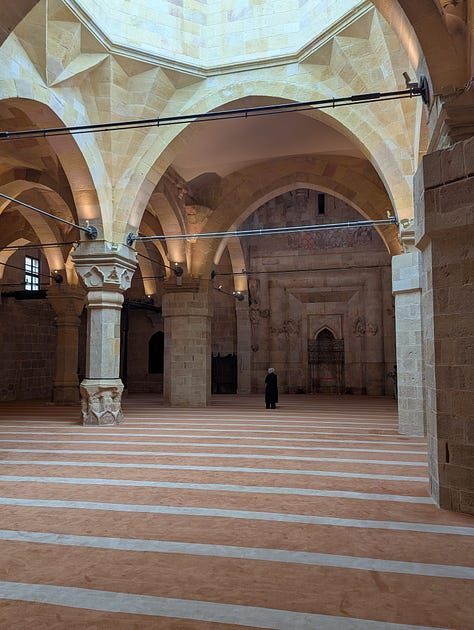
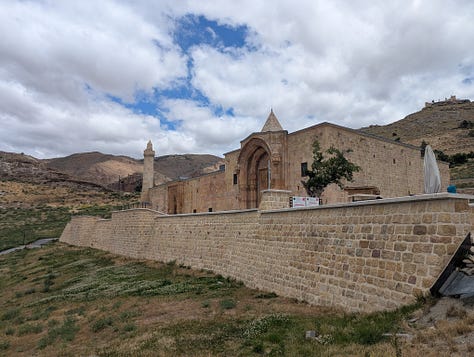
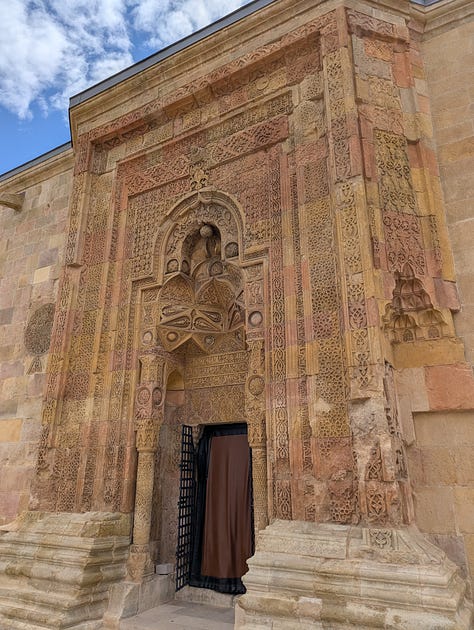
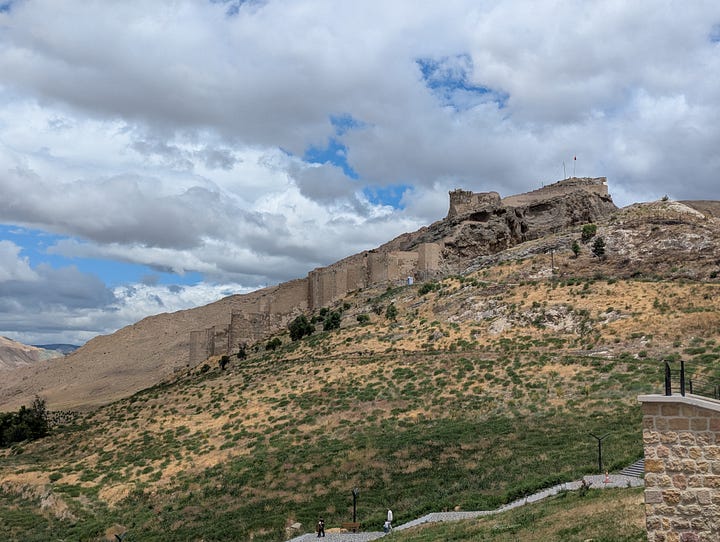
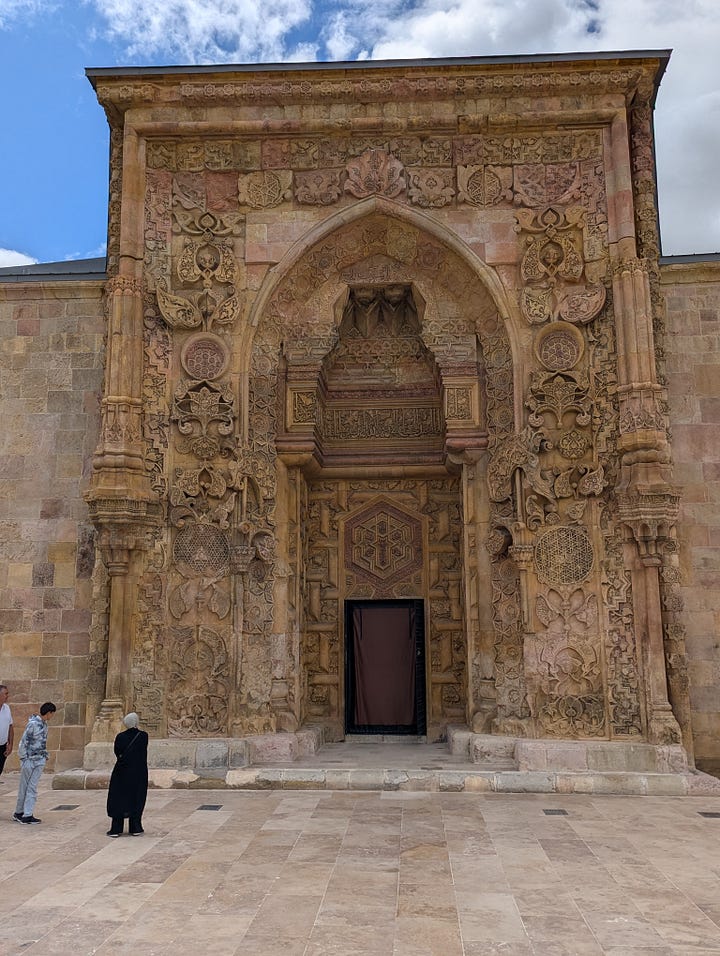
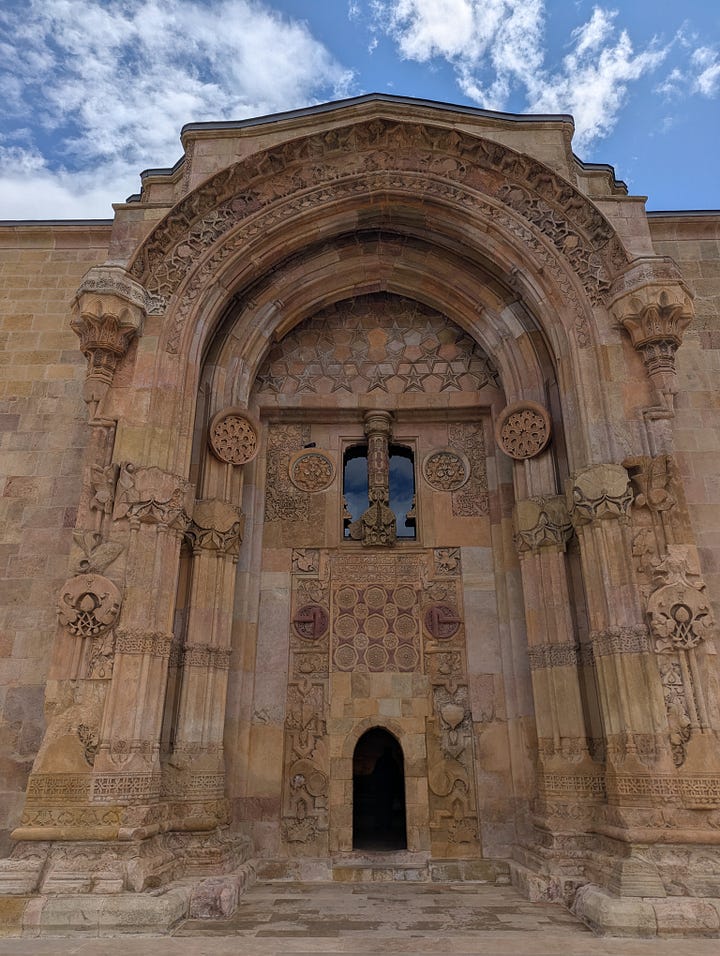
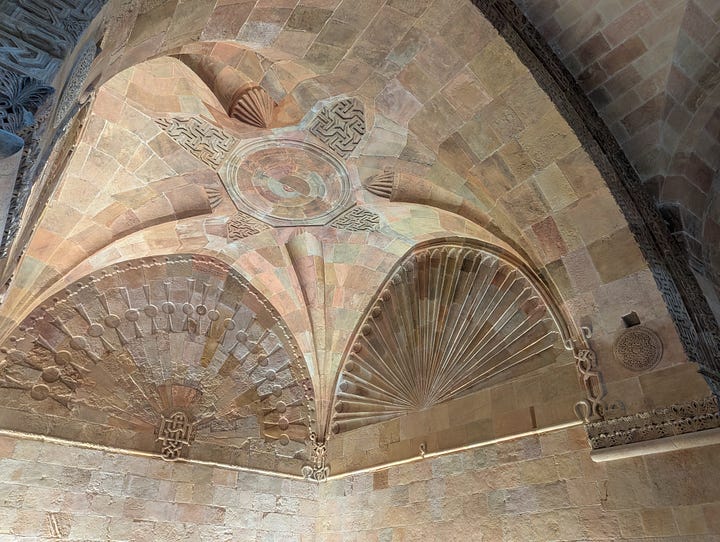
1-July-2025: Divrigi to Erzurum
We woke up early, which was relatively easy given we had slept most of the afternoon the day before, and enjoyed a hearty Turkish breakfast before departing the hotel and making our way to the station. The train was scheduled to depart at 8:18am, but was two hours late - the same as our arrival in Divrigi. Maybe this is the “real” schedule. We suspected the train would be late, but didn't want to risk timing our arrival based on this assumption given there is only a single train each day. Luckily it was a pleasant day and we didn't mind sitting around for a couple of hours.
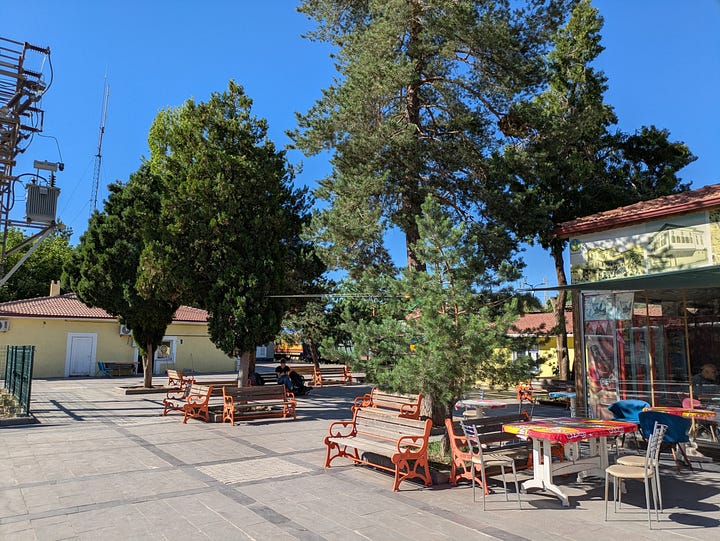

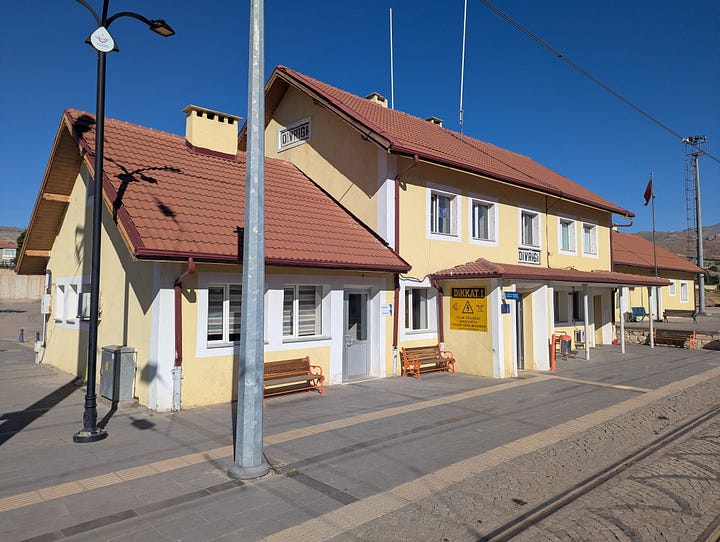
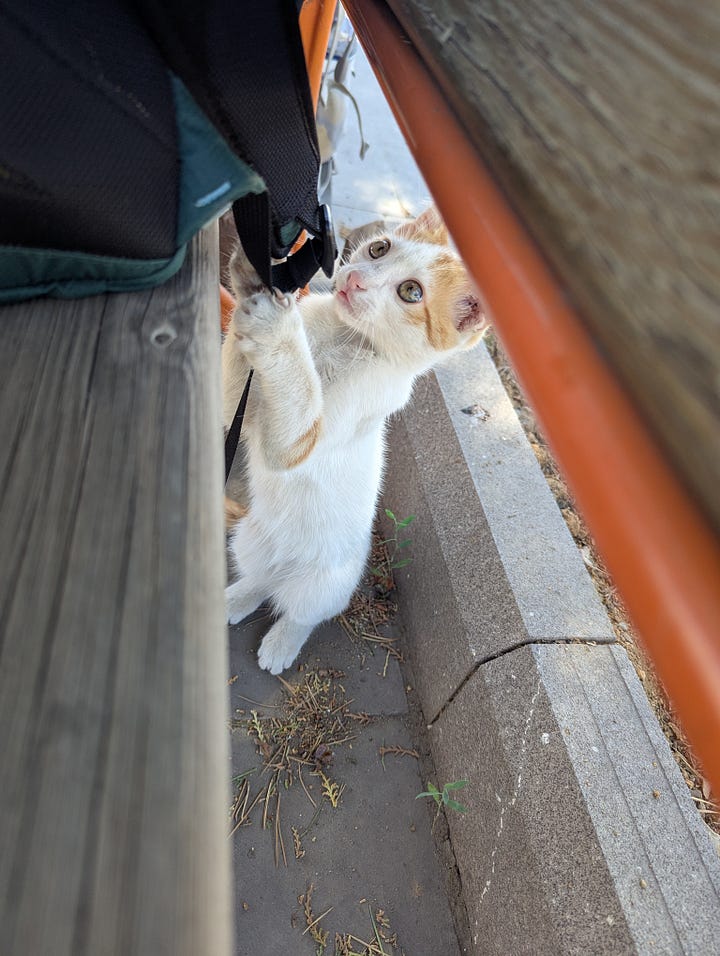
The train continued through valleys of various width and depth, past hydroelectric facilities, and climbed as we headed east. Interestingly, the landscape was less arid as we gained elevation and our surroundings became a bit greener. Rather than rockey and sandy soils and mountains, grass and some trees covered the slopes of the valley. The river water looked clearer and the agriculture less dependent on irrigation.
Most of the journey wound its way past tiny villages, typically with only a couple dozen ramshackle houses at most. Some agricultural buildings had piles of manure either drying in the sun or covered with tarps - we had read somewhere that in the high elevation regions of eastern Turkey dried manure has historically been used as fuel for heating in the harsh winters.
The largest settlement we passed through on route to Erzurum was Erzincan. The rail line skirted the edge of the city of some 150,000 people, but even so we could tell that it looked relatively new. We had considered stopping in Erzincan, but decided against it after some preliminary research. The city was completely destroyed by a massive 7.8 magnitude earthquake in December 1939 - tying the 2023 earthquake in the south of Turkey for the most powerful recorded in the country. The damage was so severe that the old city was abandoned and the new one rebuilt slightly to the north; by the end of 1939, nearly 33,000 people had died in earthquakes and floods that struck the city.
The immediate landscape flattened as we approached Erzurum. The city is on the edge of a plateau about 1800m above sea level. The plateau is surrounded by mountains in all directions, the highest of which rise above 3000m and make Erzurum a popular winter sports destination. In July, only small patches of snow remained on sheltered north facing areas and the mountains provided a spectacular backdrop for any view.
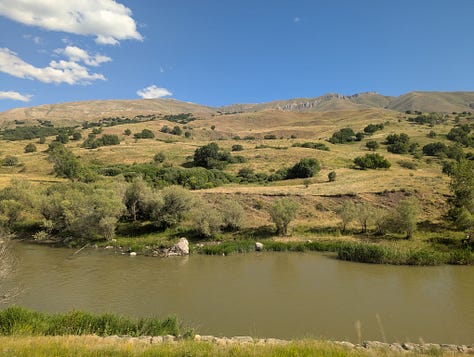
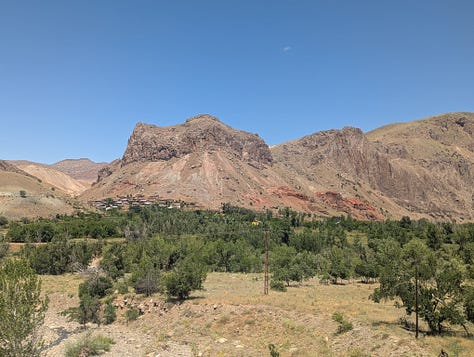
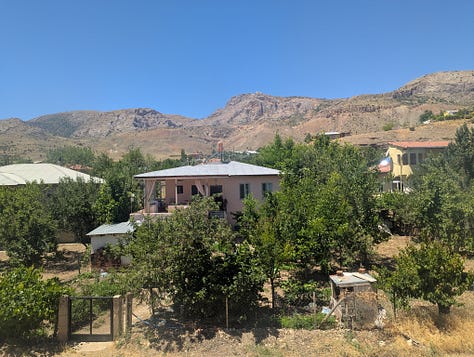
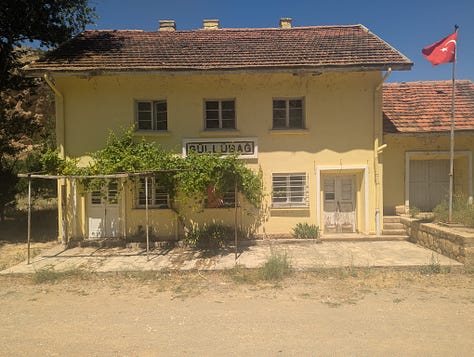
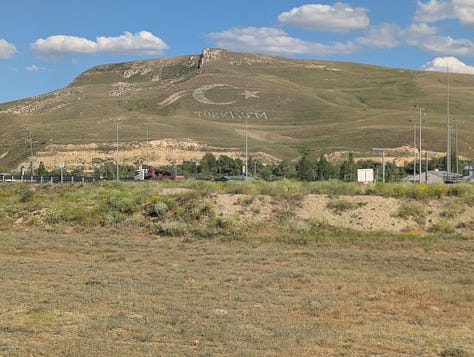
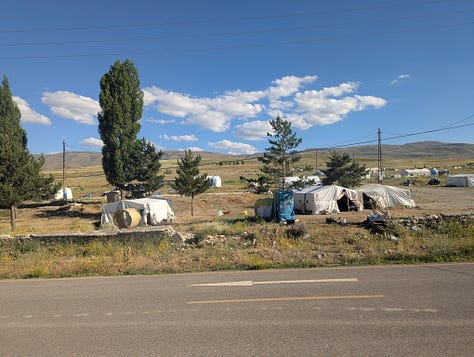

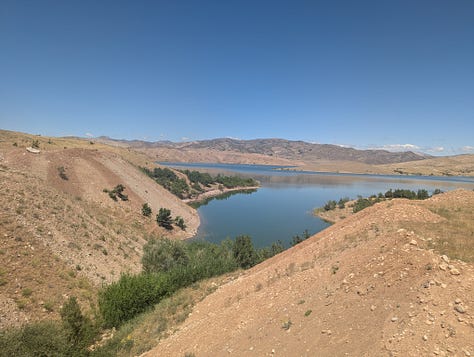
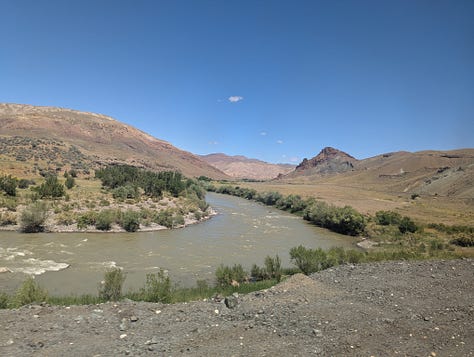
2-July-2025: Erzurum
As our train arrived in the evening, we decided to stay two nights in Erzurum, giving a full day to explore the city. Erzurum is not a huge city, but with a population around 500,000 it has plenty of amenities and is a major centre in the East of Turkey. Once again, we were the only foreign tourists that we noticed in the city. Despite the lack of international tourists, the city featured plenty of attractions to fill our day.
Erzurum has been on the frontiers of various empires for centuries. Its castle is believed to be originally built by the Byzantines in the 5th century. In the middle ages, it was ruled by Arabs, Seljuks, Ottomans, and Russians (among others). Many of the historical buildings in Erzurum have been beautifully restored, so we made our way through past most of them.
The castle charges foreigners a €3 admission, which is paid in lira and in cash - this has been pretty common in Turkey, perhaps it keeps the foreigner charges sufficiently high without having to change the signs when the lira weakens (as it has regularly in recent times). For the most part, the inside isn't too interesting. There are a couple large stacks of cannon balls, an old restored mosque, and the clock tower in the corner. Otherwise, the interior is a ruin with just some foundations showing through the soil. The best part of the visit is climbing the clock tower, originally built in the 12th century as a minaret, for a pretty good view over the city.
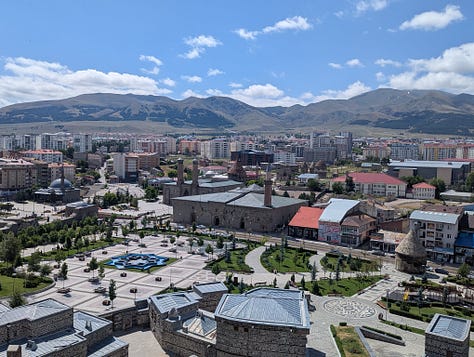
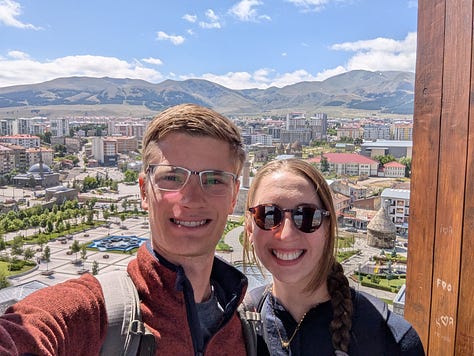
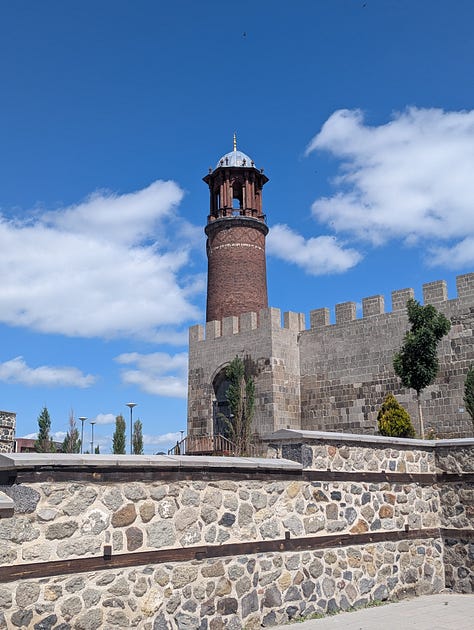
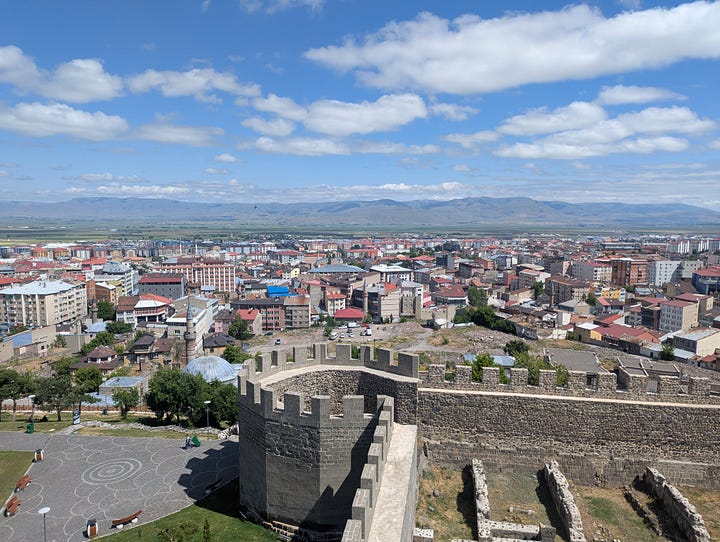
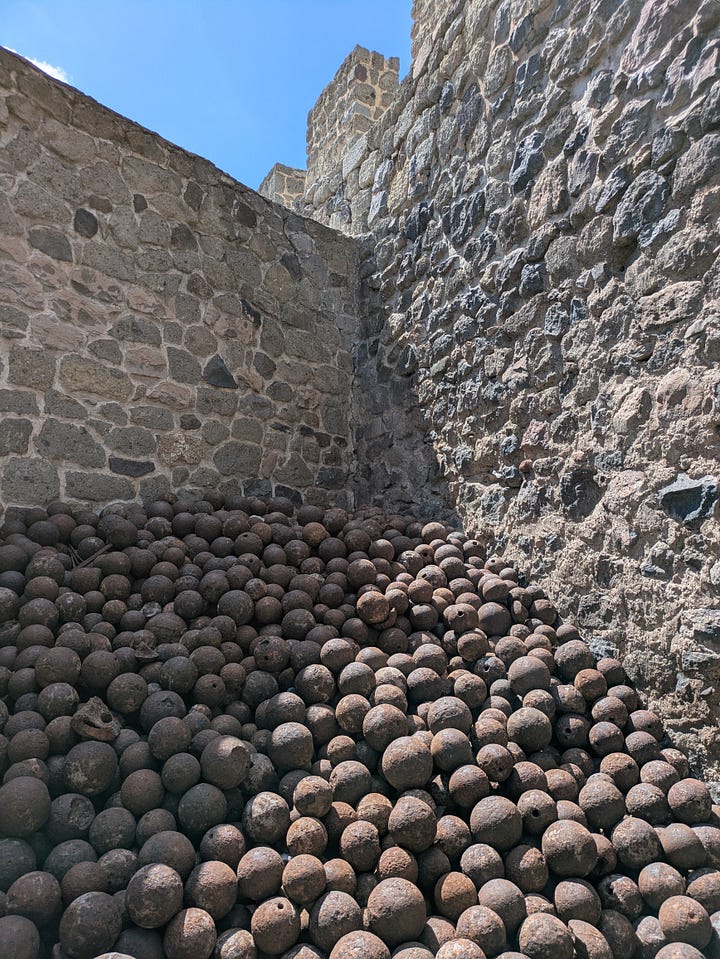
Next, we stopped at Erzurum Ulu Camii (or Grand Mosque). The mosque was built in the 12th century, has a rectangular plan, and is generally rather plain. The most impressive aspects of the mosque are its size - it allegedly has a capacity of 10,000 people - and a wooden “swallow dome” created by corbeling timber beams.
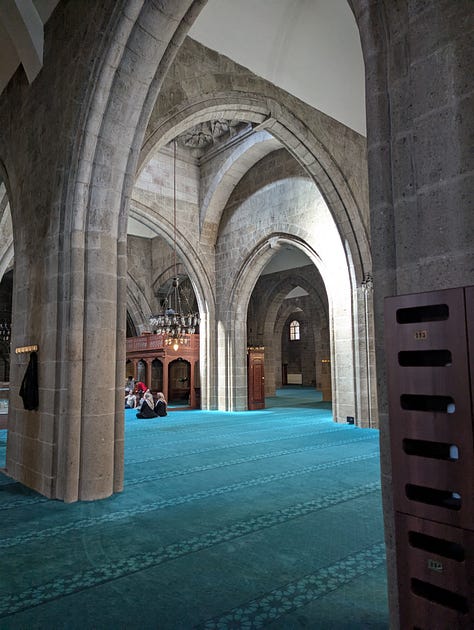
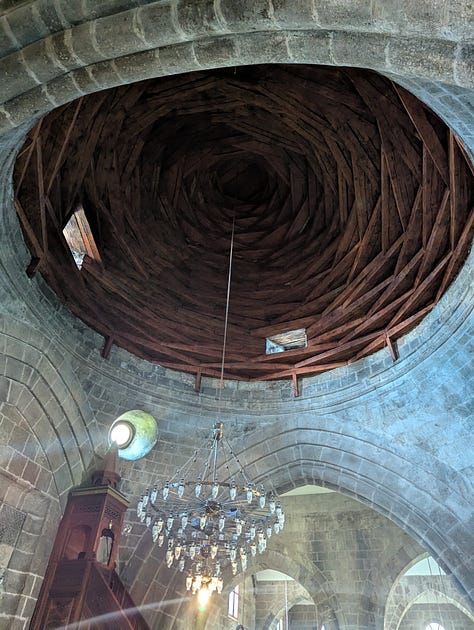
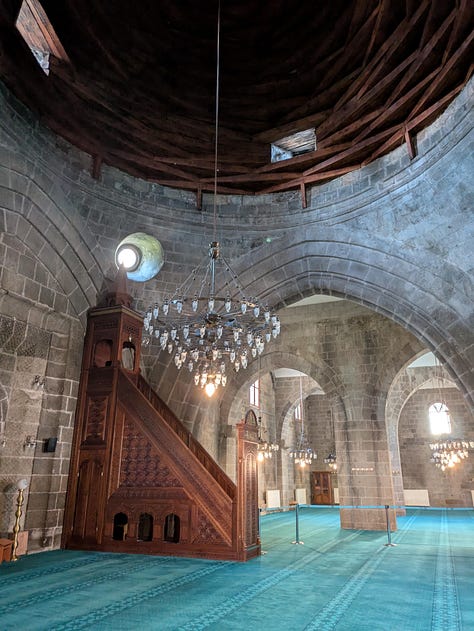
Beside the Grand Mosque is the 13th century Double Minaret Madrasa - a religious school built during the Seljuk period. The two minarets which give the madrasa its name are decorated with ornamental brick and tile and the facade is intricately carved. The entrance may be the main attraction, but inside there is also a free museum which is well worth visiting.


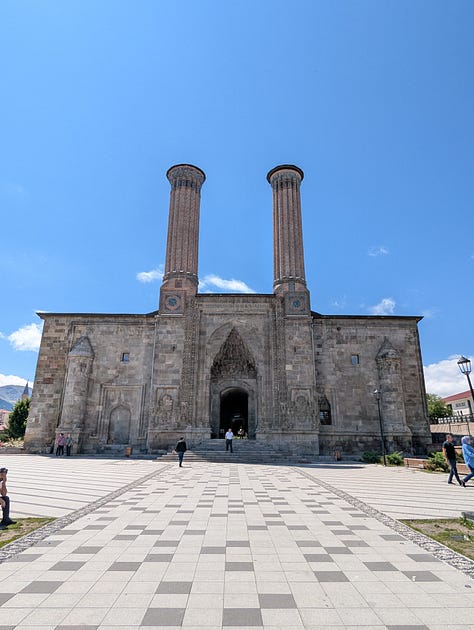
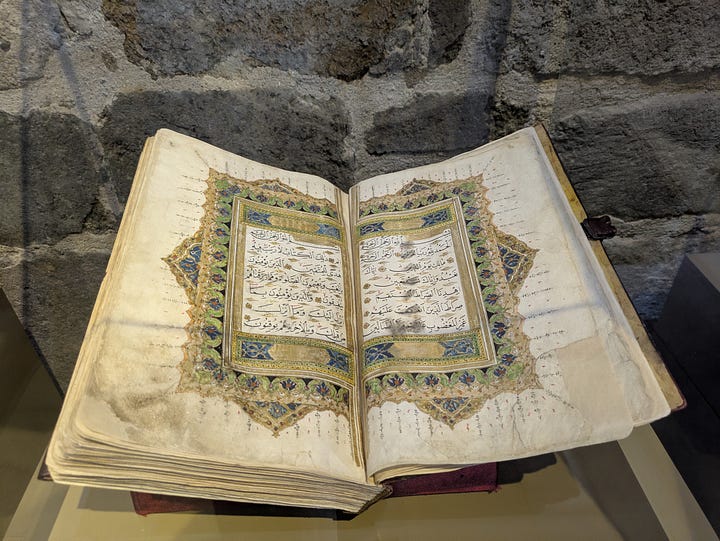
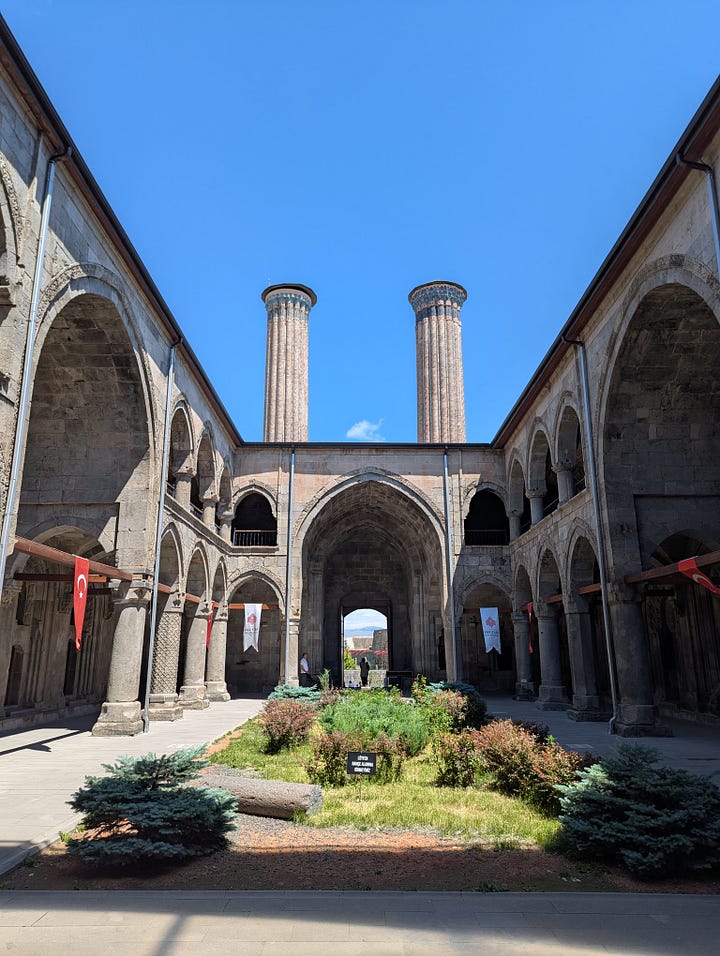

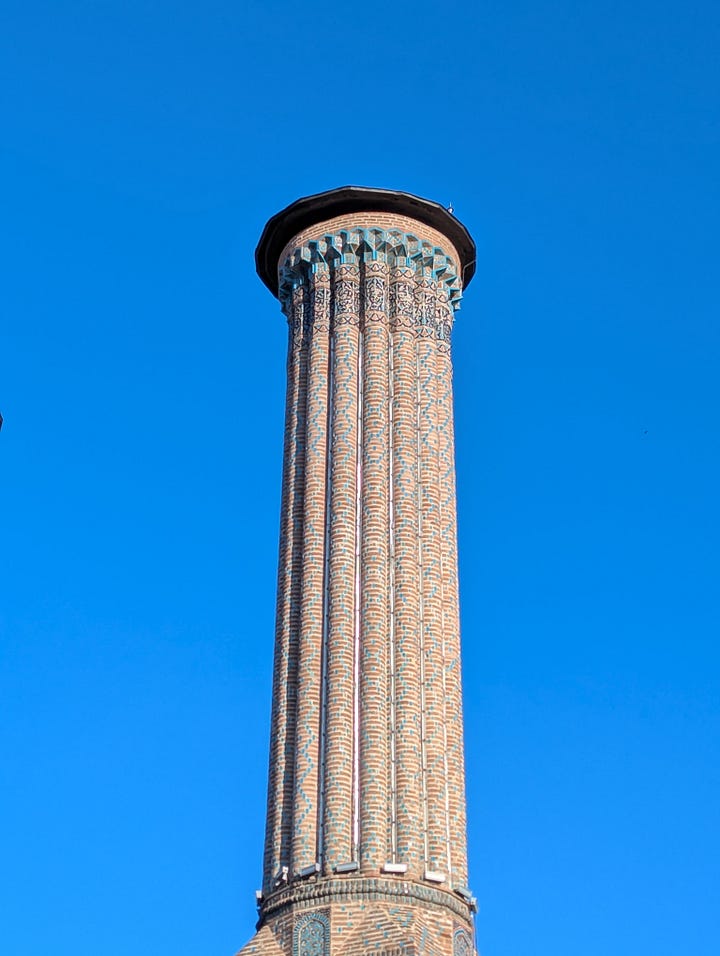
Behind the mosque and the madrasa, we visited three monumental tombs built between the 12th and 14th centuries. The largest and oldest tomb belonged to Izeddin Saltuk who governed the Satukid principality. The identity of the people buried in the other tombs is unknown.
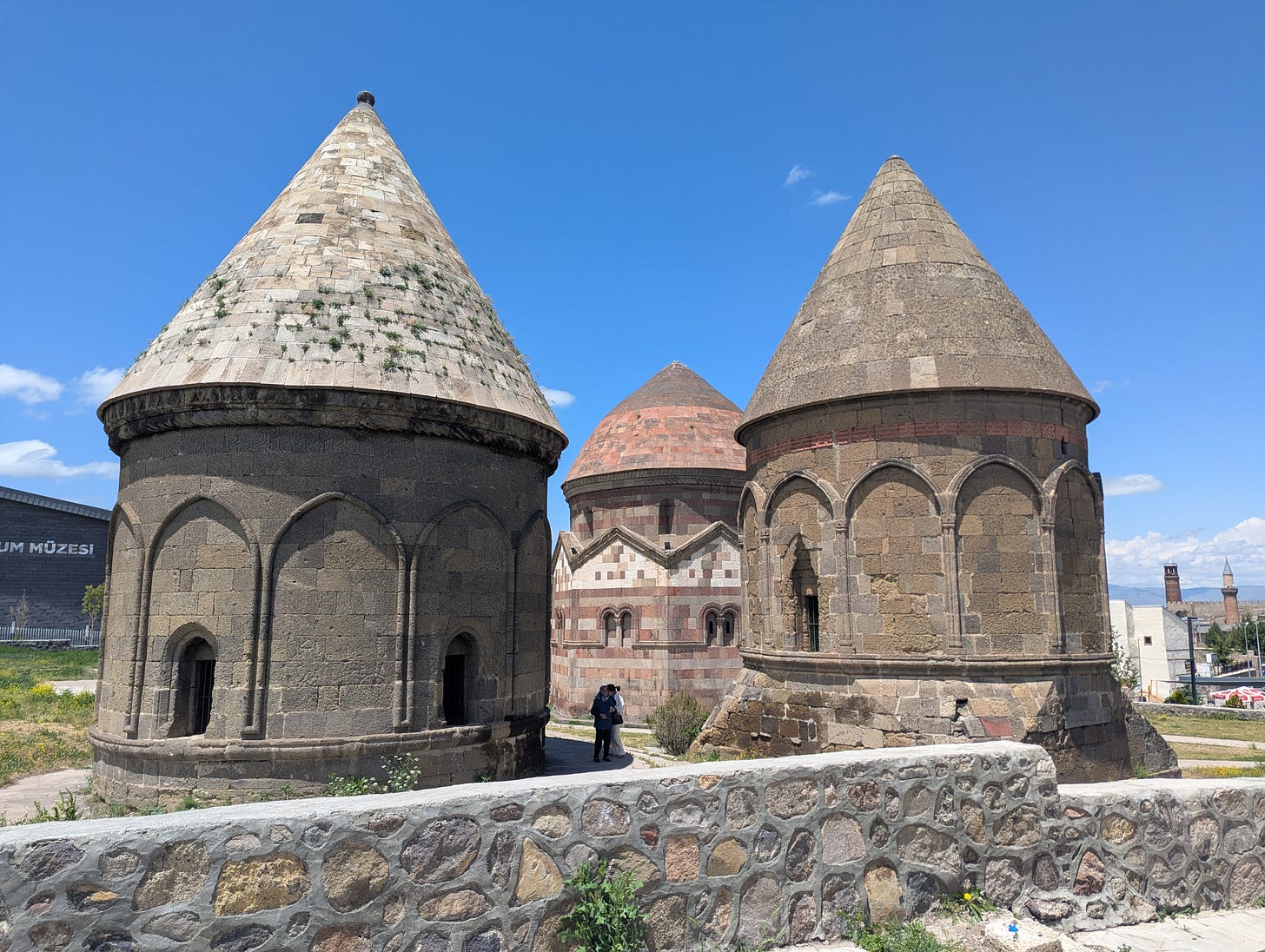
While at the tombs, we were greeted by a man named Hakem at the adjacent Paşa Bey Konağı - a 300 year old house which he grew up in and has subsequently turned into a museum. Hakem guided us through the house telling us about each room. He pointed out a corbeled “swallow roof” in the kitchen/livingroom, separate door knockers for men and women on the front door (included so the suitable gendered resident could answer the door), a beautifully carved ceiling in a upstairs sitting room, and then brought us tea in a second sitting room (we believe this room was for women). After finishing our tea, he insisted on dressing Mary as a “sultana” and taking some rather hilarious pictures in “throne” along one wall (Mary insisted these not be made publi, so you’ll have to use your imagination). After our friendly private tour, we bid Hakem farewell and left a donation for the upkeep of his museum house - definitely a highlight of Erzurum.
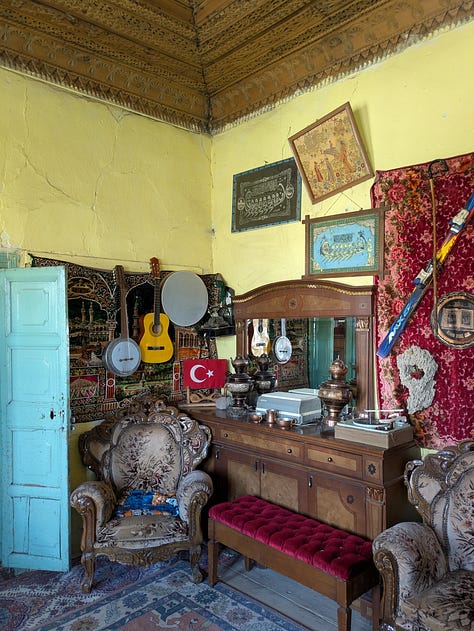

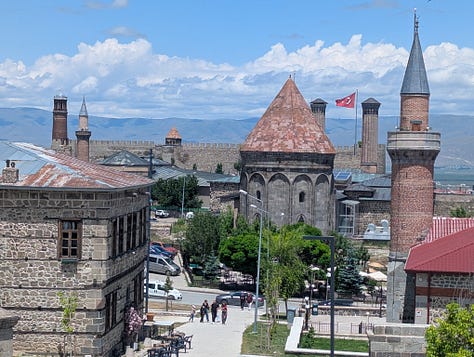
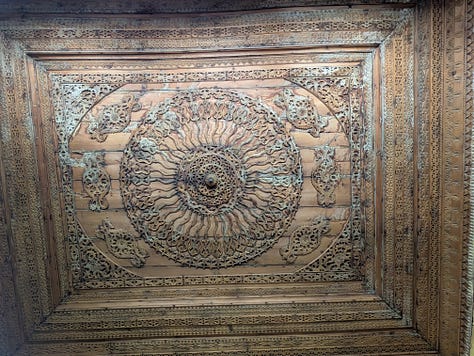

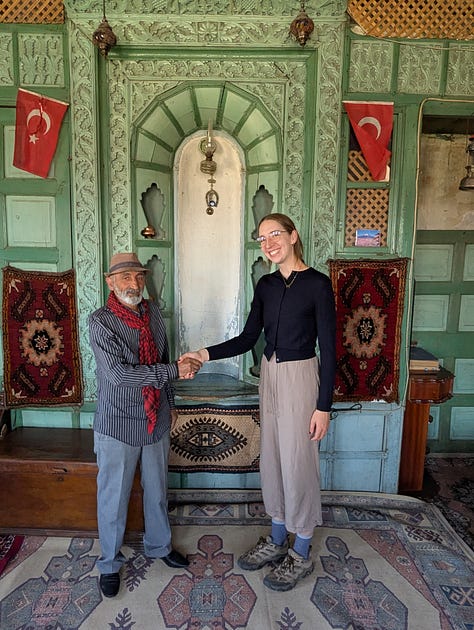

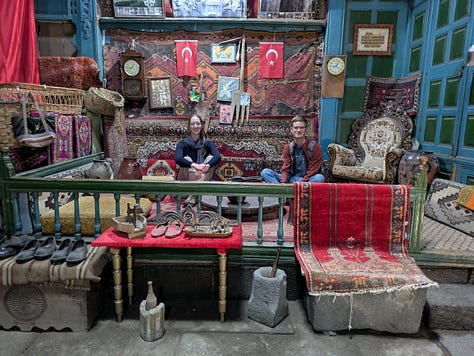
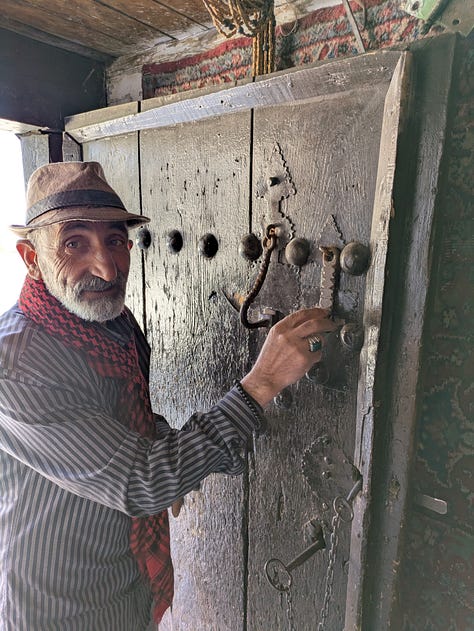
Lastly, we visited Yakutiye Madrasa. The Madrasa also features a stunning facade and includes a covered courtyard inside. This Madrasa also housed a museum which is dedicated to traditional dress and industries in the region - it charged a €3 admission fee.
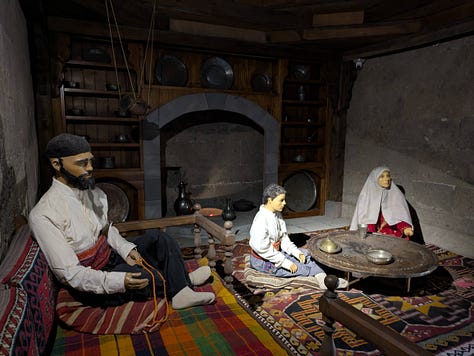
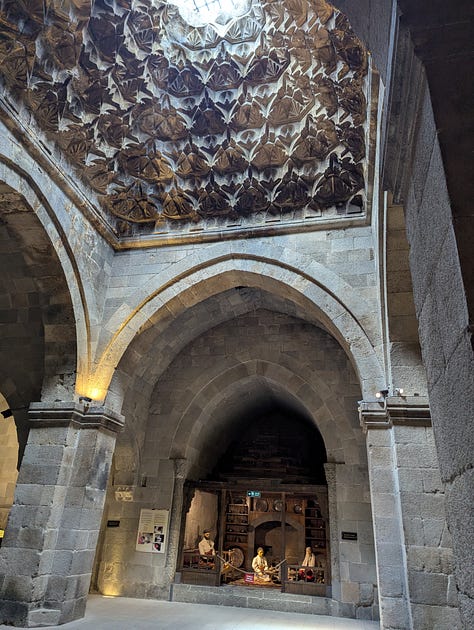

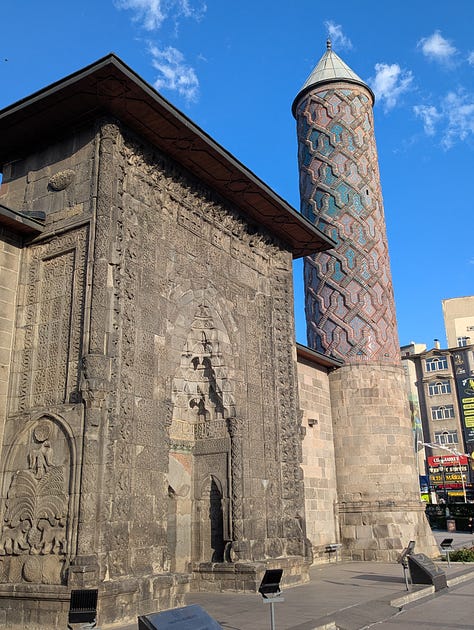
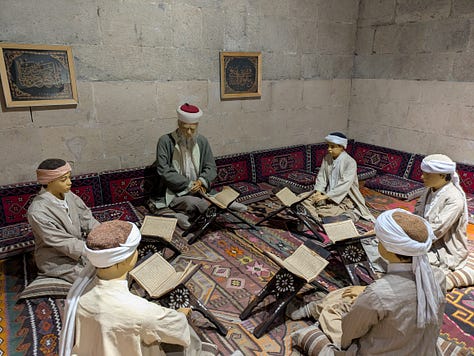

Food in Erzurum
While in Erzurum, we tried some specialities of Eastern Turkish cuisine. The first evening in Erzurum, Scott tried Cağ kebabı. This style of kabab originates in Erzurum and features marinaded lamb which is cooked on a horizontal spit over a wood fire. Unfortunately, the restaurant didn't serve much other than Cağ kebabı, so Mary was stuck eating a salad!

We tried Kadayıf Dolması, a dessert which also originates from Erzurum, a couple of times while in the city. Chopped walnuts are wrapped in a shredded pastry and the whole thing is fried in hot oil. Before serving, the log shaped dessert is smothered in syrup. The result is a intensely sweet nutty treat with a satisfying crunch from the frying. It's the kind of thing you just want to keep eating, but due to the sweetness it's best not to eat more than one or two at a time!

Soup is also common in Erzurum, probably due to the long harsh winters in the region. Although we visited in the summer, we made a couple stops at a Karaköy Çorba Evi (Karaköy Soup House). The restaurant serves exclusively soup and had 20 varieties available. Prices ranged from 90-145 lira for a bowl (roughly €2-3.5) and included unlimited bread to soak up the delicious broth. Mary tried a vegetarian “Sour Soup” both times we stopped in while Scott mixed it up with a meaty “Yogurt Soup” the first visit and a fatty soup with a spicy broth (we have no clue what it was called) the second.
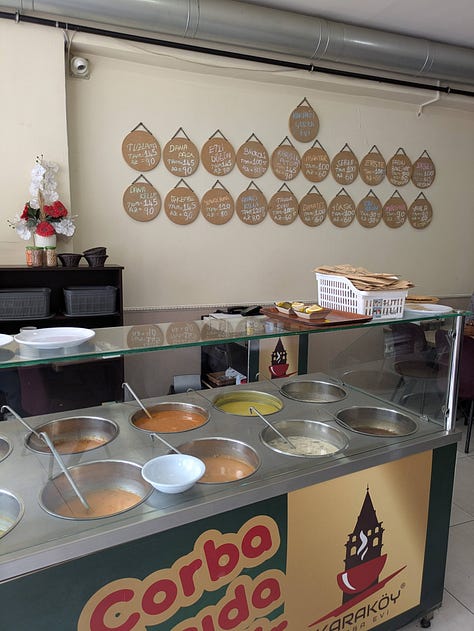
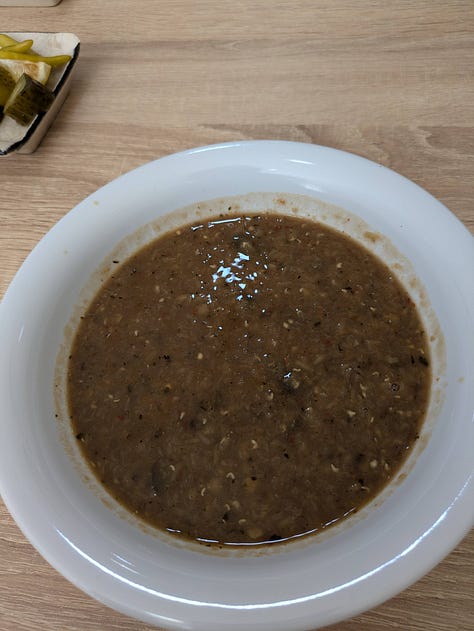
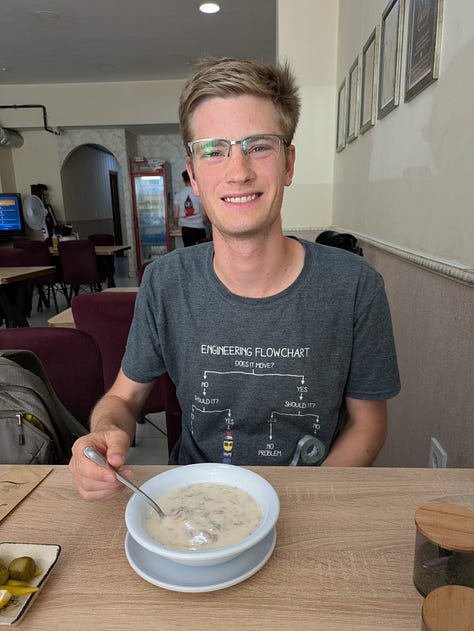
3-July-2025: Erzurum to Kars
The final leg of our journey on the the Dogu Express was scheduled to depart Erzurum at 4pm, although if our experience on previous days was any guide, it would almost certainly be late. Our hotel checkout was at noon, so we wandered slowly through Erzurum, stopped for a coffee near the castle, had a bowl of soup for lunch, then made our way to the station to buy our tickets about 2pm.
The ticket desk attendant called another man over when he saw our passports - this other man turned out to be the “officer on duty” who must have been fairly important as he had his own office. He was rather excited to talk with foreigners and produced a collection of Turkish coins which he gave to us - probably everything up to a 5 lira coin. Unfortunately, neither of us had a Canadian coin to exchange. Our Google translate conversation continued with the man asking what we thought of America wanting to make Canada a state. Scott politely explained our disapproval of the orange southern neighbor’s proposal which the man found quite funny and said, slightly less politely, that he did not think very highly of President Trump - in Turkey it is illegal to insult the president, but it would appear this protection does not extend to foreign leaders.
As our tickets were being processed (this is a bit of a process as our passport information has to be entered and linked to the ticked), the man explained that the train would be 3-4 hour late and offered to let us leave our backpacks in his office so that we could wander Erzurum while when waited. Although we'd seem a good part of the city already, we took him up on his offer and made a stop at the Atatürk House museum (many cities where Atatürk stayed at one time or another have such a museum, but this is the first one we visited).
We still ended up spending a couple of hours sitting in the train station and due to the train’s delay the journey to Kars was in the dark so we didn't get the chance to see any scenery on this leg of the journey.
Notes on Tea (Çay):
We've now been in Turkey for a while, and learnt a lot about tea culture. Turkey is known for its “Turkish Coffee”, dating from the era of the Ottoman empire, however nowadays tea is by far the dominant drink in Turkey. As we've crossed the country, tea has been a constant across all regions.
Everywhere you go, at any time of day, there will be people drinking tea together. This is in contrast to the Balkans, where coffee is the drink of choice (adapted from the times of the Ottoman empire i.e. “Bosnian coffee” which differs only slightly from “Turkish coffee”). However, the culture around Turkish tea or Balkan coffee is similar, in that the ritual is social, the cups are tiny, and it is to be drunk at all hours of the day.
From what we've discovered online, despite centuries of tea travelling through Anatolia via the silk road, tea has only become widespread in Turkey during the 20th century. After the dissolution of the Ottoman empire and during the post WW1 era, coffee was expensive and at times unavailable as it's grown in Yemen, which was no longer part of the Ottoman empire. As such, tea drinking was encouraged as an alternative to coffee. In 1924 the Turkish government passed a law promoting tea cultivation in the eastern black sea region. The tea is Rize tea, a terroir from Rize province on the Eastern Black sea coast. Rize has a mild climate with high precipitation and fertile soil. Rize is a black tea that has a very red color when brewed. The tea shrub is called Camellia sinensis. Two of this plant’s five varieties are harvested and then processed differently to make white, green, yellow, dark, oolong and black tea.
By the mid 20th century, tea had become the choice drink in Turkey. Today, according to Wikipedia, Turks drink the most tea per capita, over 3 kg per year. In 2019 Turkey produced 1.45 million tonnes of tea and 1.26 tonnes were consumed domestically. This isn't surprising as everywhere we've gone in Turkey, at any time of day, the villages, cities, bus stations, parks, and any gathering place is full of people sitting together at low tables drinking tulip shaped cups of red tea placed on small platters with sugar cubes and a tiny stirring stick or spoon. In some regions beet sugar is used and the traditional way is to place the sugar cube under your tongue before taking a sip of tea (rather than mixing it in the cup).
The tea drinking ritual is very special, and we've been told that the tulip shape of the small cups is to encourage slow drinking. This is in contrast to eating here. We've noted in Turkey that if we sit in a restaurant and don't finish our food quickly, it's liable for a waiter to come and whisk away an unfinished plate. Another quick Google search revealed that in Turkish culture, it has traditionally been seen positively to eat food quickly and get up. In villages there was a lot of farming work to be done; it was looked upon positively for people to eat quite quickly as they didn't have much time to spare. We even read that if people notice a child eating quickly, it may be said that that child will go on to be successful in life. We prefer eating a bit slowly to chat and digest comfortably, however in Turkish culture drinking tea slowly and for hours on end seems to be the compromise for the need to eat quickly.
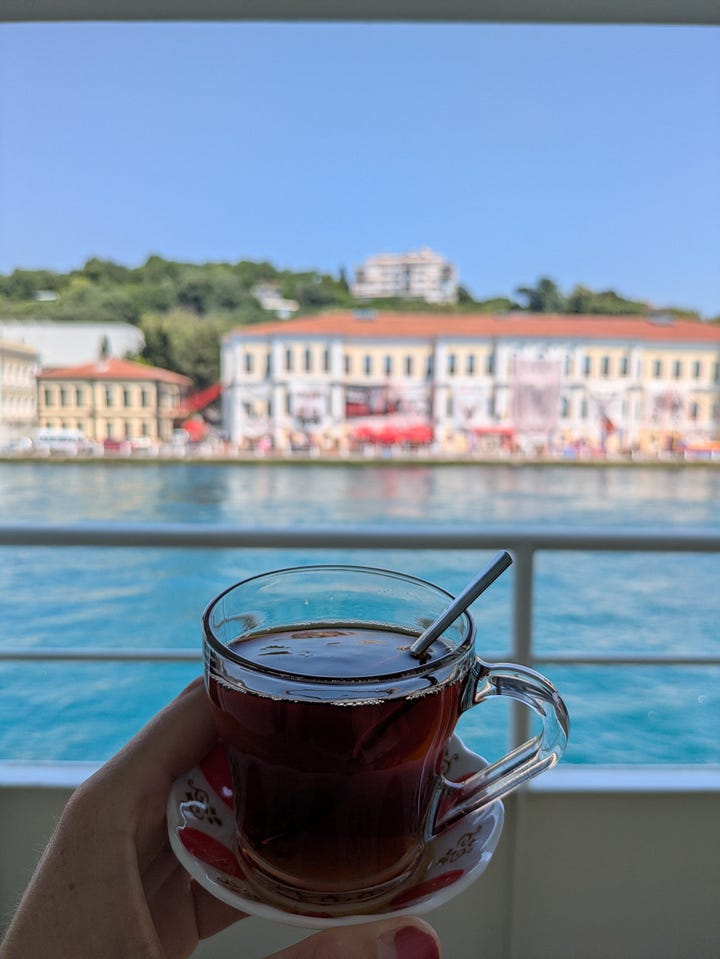

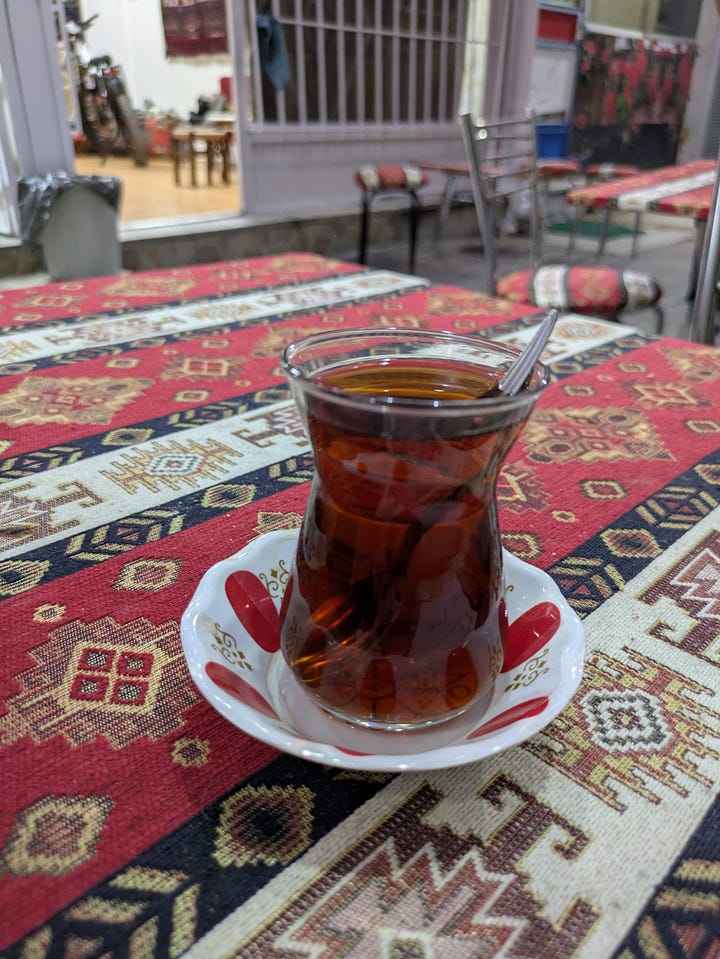
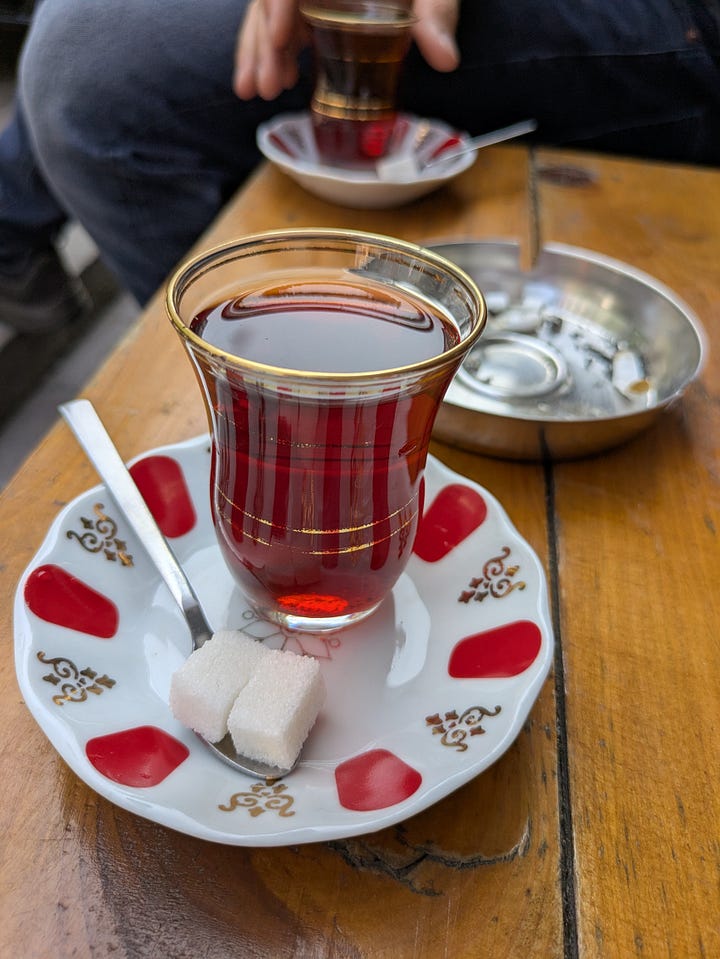
Another important thing to note is the way that tea is brewed here. Double or stacked tea pots are used in order to brew strong tea on the top teapot, with the option to drink tea strong or to dilute the tea with hot water from the bottom vessel. We even noticed large wood burning tea contraptions to this effect in the mountainous region of Erzurum. The modern kettles used in Turkey also reflect this and allow for the traditional tea making method.
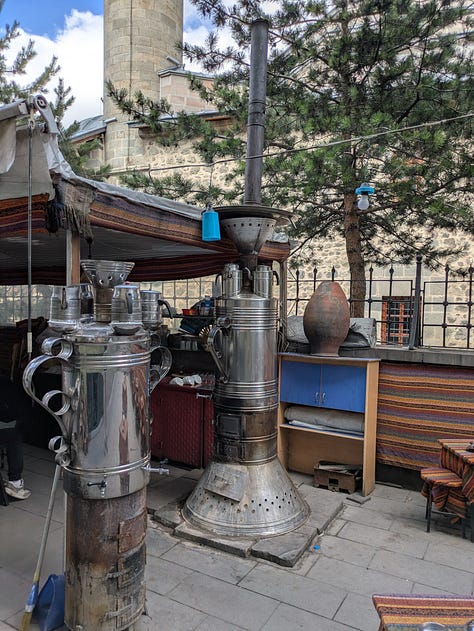
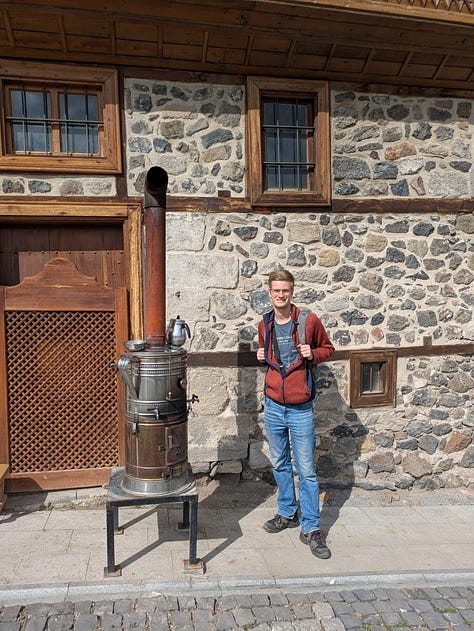
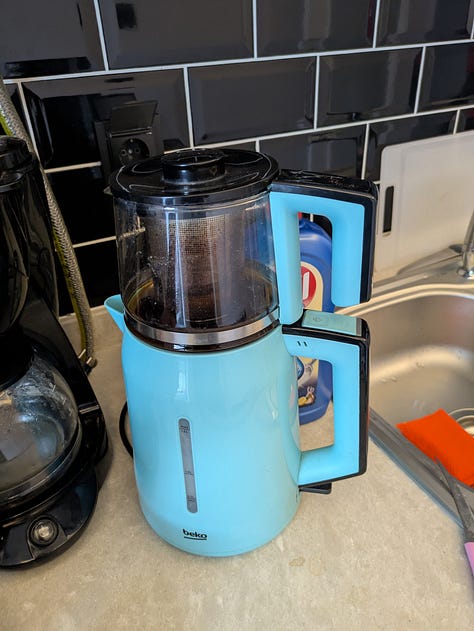
Travel Stats
We covered quite a lot of distance in this section of our trip, travelling from central Turkey to the far east of the country. The bus from Göreme to Kayseri covered 64km in about an hour while our three leg journey on the Dogu Express covered 986km in just over 21 hours (plus a lot of waiting around for delayed trains).
We walked less than usual since we spent so much time on the train. We did still manage 36.4km or 7.3km/day. This takes our 178 day total to 2427km!
To Be Continued…
We will be spending a few days in Kars, then we will be aiming for the Georgian border. Our schedule and route are still to be determined, so keep an eye out for our next updates to see how we get on!

